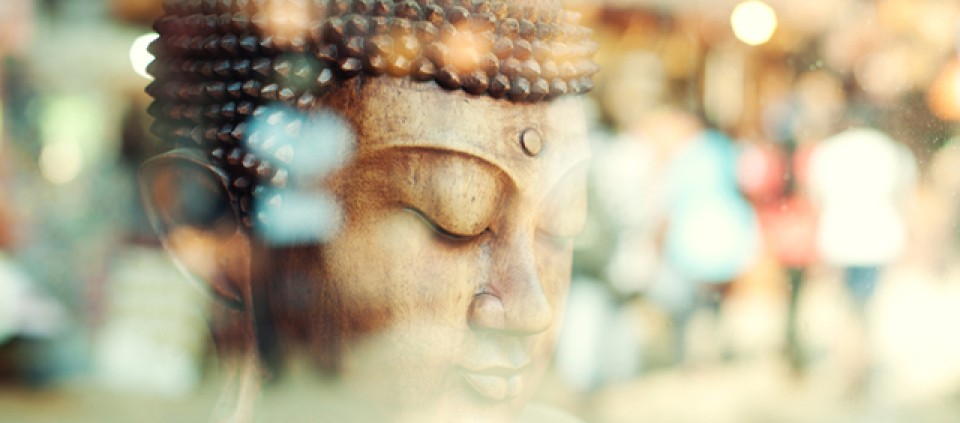Not Too Tight, Not Too Loose

by Tresca Weinstein
There’s a well-known story about a sitar player (in some versions, it’s a lute player) who was discouraged with his meditation practice and went to the Buddha to ask for instruction.
“What happens when you tune your instrument too tightly?” the Buddha asked.
“The strings break,” the musician replied.
“And what happens when you string it too loosely?”
“When it’s too loose, no sound comes out,” the musician answered. “The string that produces a tuneful sound is not too tight and not too loose.”
“That,” said the Buddha, “is how to practice: not too tight and not too loose.”
I love the elegant simplicity of this story, which Frank Jude Boccio told on the first night of his Kripalu program recently. The balance between too tight and too loose—at least the way I interpreted it before the program—is something I think about a lot, in yoga class and in life. Do I want to do Half-Shoulderstand at the end of class, or relax into Savasana? Should I stay for the half-hour meditation session, or go eat dinner? Do I have to wash the dishes, or is it okay to let them sit overnight so I can watch The Daily Show? Should I buy that great pair of boots, or put the money someplace more useful?
For most of my life, I’ve been strung a little loose, so to speak: My tendency has been to go with what feels easier and more comfortable. I’d look at my type-A friends, the ones jogging up mountains and working high-powered jobs, with sympathy, not envy. In recent years, though, I’ve begun to really enjoy rigor and challenge—pushing through a tough workout or choosing to meditate even though my mind tells me I don’t want to. (I’ll still buy the boots, though, just about every time.)
I was curious to see what Frank would have to say about all this. I’d done Mindfulness Yoga (his fusion of the two practices) with him in the past, so I knew he was totally down-to-earth, approachable, funny, and real—like your cool older brother, if your cool older brother had studied Buddhism for seven years with a Korean Zen master (Samu Sunim, who ordained Frank and gave him the Zen dharma name Poep Sa). In a single dharma talk, Frank can effortlessly quote everyone from his longtime teacher Thich Nhat Hanh to performance artist Laurie Anderson, deconstruct complex philosophies and principles, and weave in stories about his two-year-old daughter or his days as a punk in New York City in the 1980s.
During the five days of the program, we explore the balance of effort and surrender (abhyasa and vairagya, in Sanskrit) through yoga practice, meditation sessions, and discussion. We look at Patanjali’s examination of these complementary qualities in the Yoga Sutras, along with the Buddha’s teachings on the Middle Way—the path between indulgence and asceticism, looseness and tightness. I begin to feel in my body what Frank describes as the non-duality of effort and surrender: “They sound completely different, but in reality, in every given moment, both are there. There is no separation between them,” he says. As I hold Warrior I pose, I can feel the effort, the surrender into effort, and the effort of surrendering—all at the same time.
In meditation, finding the balance, for me, comes down to what seems like tiny details: Can I straighten my lower back a bit more? Do I need to scratch my nose right now, or can I just be aware of the itch? The great thing is that losing focus is as much a part of meditation practice as finding it. “The moment when you realize the mind has wandered, you are at your most awake,” Frank says. He offers various options for us to try—staying inwardly focused as we count the breath; opening and expanding our awareness; and invoking the qualities of mountain, lake, and sky. The image he gives us to represent the quality of meditation is that of a butterfly perched lightly but securely on a leaf. There it is again: not too tight, not too loose.
So what does this look like in daily life, off the mat and meditation cushion? As Frank explains it, the balance lies between stimulation and spacing out. In the neutral moments that make up most of life, when we’re neither suffering nor ecstatic, we can practice mindfulness—paying attention to what arises, without judgment. There’s a kind of bliss to be found there, a “subtle spaciousness,” as Frank calls it. From that place of awareness, the decision of whether to wash dishes or watch TV, eat or meditate, comes naturally, and the action unfolds with greater ease. “Whether you’re changing diapers or doing Triangle, what’s the way we can go into it with the least stressful effort?” Frank asks. I think about this as I’m driving, folding laundry, walking up a steep hill and noticing—even as I get short of breath—the warm air and the way the leaves on the trees around me tremble between green and silver in the breeze.
The process of fine-tuning never stops; you can’t get to the perfect tautness and just stay there. “The story of the lute player makes it sound as if there’s a set point, but everyone who plays an instrument knows that if you go into a dry, hot room, or if it’s a really humid day, you have to retune,” Frank says. “Part of mindfulness is being aware of that, and always making adjustments.” There is no Auto-Tune for life.
Tresca Weinstein is Kripalu's Features Editor and a freelance writer for numerous publications and websites.
© Kripalu Center for Yoga & Health. All rights reserved. To request permission to reprint, please e-mail editor@kripalu.org.